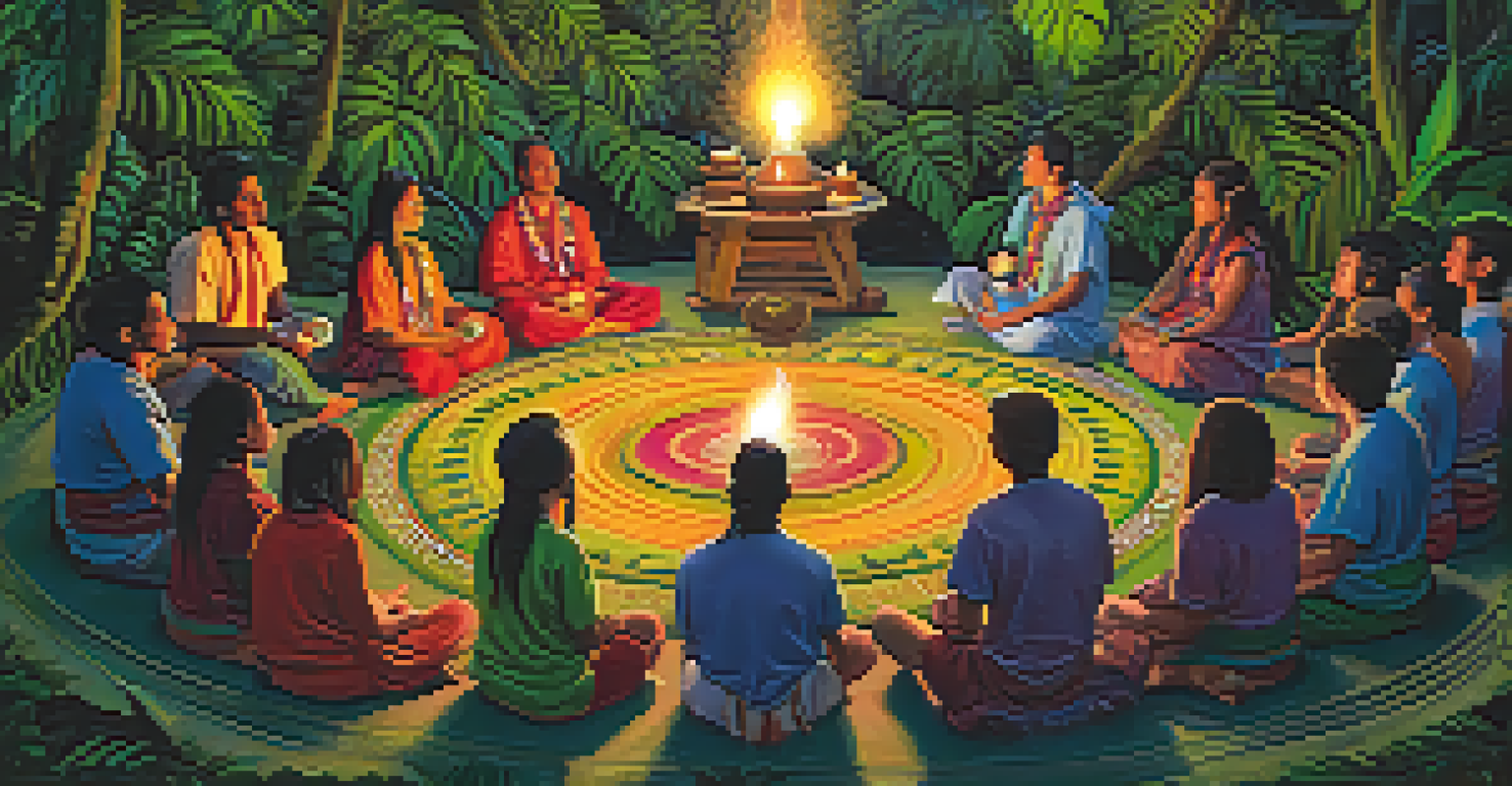Ritualistic Practices: Amplifying Hallucinogenic Effects

Understanding Hallucinogens: A Brief Overview
Hallucinogens are substances that alter perception, mood, and cognitive processes. They can be derived from plants or synthesized in labs, with examples including psilocybin from mushrooms and LSD. These compounds often lead to profound changes in consciousness, which can be both enlightening and disorienting.
The experience of a hallucinogen can be profoundly influenced by the set and setting in which it is taken.
The effects of hallucinogens can vary significantly depending on the individual, the setting, and the dosage. Some users report experiences of heightened creativity, deep emotional insights, or a sense of connectedness to the universe. However, the unpredictability of these substances means that they can also provoke anxiety or confusion.
Ritualistic practices surrounding the use of hallucinogens can amplify these experiences, creating a framework that enhances the potential benefits while mitigating risks. By understanding the cultural context and intentionality behind these rituals, we can appreciate their role in shaping hallucinogenic journeys.
The Role of Rituals in Hallucinogenic Experiences
Rituals are structured activities that often involve symbolism, community, and intention. When incorporated into hallucinogenic practices, they help users focus their minds and set clear intentions for their experiences. This can significantly influence the outcome of a hallucinogenic journey.

For instance, many indigenous cultures have long used rituals in conjunction with hallucinogenic plants during ceremonies. These rituals often include music, dance, and communal sharing, creating an environment that fosters support and understanding among participants. This communal aspect can transform individual experiences into collective journeys.
Hallucinogens Alter Perception
Hallucinogens can profoundly change perception, mood, and cognitive processes, leading to both enlightening and disorienting experiences.
By establishing a shared space and intention, rituals can help users navigate the often tumultuous waters of altered states. They provide a sense of grounding and purpose, which can deepen the experience and facilitate personal insights.
Cultural Significance of Rituals with Hallucinogens
In many cultures, the use of hallucinogens is deeply intertwined with spiritual practices. For example, in the Amazon rainforest, the Ayahuasca ceremony is a sacred ritual that combines a hallucinogenic brew with traditional songs and prayers. Participants often seek healing or guidance through this transformative experience.
Rituals are the way we create the sacred space for transformation to occur.
Similarly, Native American tribes have used peyote in religious ceremonies, viewing it as a means to connect with the divine. These rituals are designed to honor the substances being used, creating a respectful relationship that enhances the user's experience. The cultural significance adds layers of meaning to the hallucinogenic journey.
Rituals not only serve to amplify the effects of hallucinogens but also preserve cultural heritage and wisdom. They remind participants of their connection to their ancestors and the natural world, enriching the overall experience.
Set and Setting: Key Components in Rituals
The concepts of 'set' and 'setting' are crucial when discussing hallucinogens. 'Set' refers to the individual's mindset, while 'setting' encompasses the physical and social environment. Rituals provide a structured setting that can positively influence a user’s mindset, leading to more profound experiences.
For example, a serene and sacred space adorned with meaningful symbols can evoke feelings of safety and tranquility. This environment encourages users to delve deeper into their experiences, fostering introspection and connection with their surroundings. The ritualistic elements help to create a sanctified atmosphere.
Rituals Enhance Hallucinogenic Experiences
Incorporating rituals into hallucinogenic practices provides structure and intention, significantly influencing the outcome of the experience.
Moreover, the presence of experienced guides or shamans during these rituals can enhance feelings of safety and support. These figures often serve as facilitators, helping participants navigate their experiences, which can be especially valuable when confronting challenging emotions or visions.
Music and Sound in Ritualistic Practices
Music plays a vital role in many hallucinogenic rituals, acting as both a guide and a catalyst for deeper experiences. Traditional songs and instruments are often used to create an immersive soundscape that encourages emotional release and connection. The rhythm and melody can evoke powerful feelings, leading to transformative insights.
In ceremonies like Ayahuasca or peyote rituals, specific musical patterns are employed to help participants navigate their journeys. The sounds can induce trance-like states, enhancing the overall experience and often facilitating communication with deeper aspects of the self or the universe.
The use of music in these settings is not arbitrary; it is carefully chosen to align with the intentions of the ritual. This intentional use of sound reinforces the communal aspect of the experience, allowing participants to feel a sense of unity and shared purpose.
Meditation and Breathwork: Enhancing Hallucinogenic Journeys
Meditation and breathwork are integral components of many ritualistic practices involving hallucinogens. These techniques help participants center themselves and prepare mentally for the experience ahead. By focusing on their breath or engaging in mindfulness, users can better manage anxiety and set a positive intention.
Incorporating meditation into hallucinogenic rituals allows participants to explore their inner landscapes with clarity. This practice can lead to profound self-discovery and emotional healing, as the combination of altered states and focused introspection creates a unique environment for growth.
Safety is Crucial in Rituals
Ensuring safety through informed participation and experienced guidance is essential for a positive and supportive hallucinogenic journey.
Moreover, breathwork can serve as a tool to deepen the experience. By controlling their breath, participants can influence their emotional and physical states, enhancing feelings of relaxation or euphoria during the journey.
Safety Considerations in Ritualistic Hallucinogenic Practices
While ritualistic practices can enhance hallucinogenic experiences, safety should always be a priority. It's essential for participants to be well-informed about the substances they are using and to engage in these practices with experienced guides. This reduces the risk of adverse reactions and ensures a supportive environment.
Additionally, understanding one's personal health history and mental state is crucial. Some individuals may have underlying conditions that could be exacerbated by hallucinogens, making it essential to approach these experiences with caution and awareness.

Creating a safe space where participants feel comfortable expressing their emotions and experiences is key to a positive outcome. Open communication and trust among participants and guides foster an environment where individuals can explore the depths of their consciousness safely.